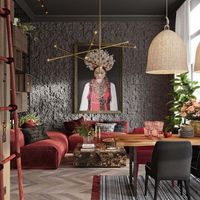## The Evolution of Entertainment: Unveiling the Modern KTV Box 3D Model
Karaoke, the art of singing along to prerecorded music, has transformed from a simple pastime to a full-fledged entertainment experience. Modern KTV boxes, with their sophisticated features and immersive design, are at the forefront of this evolution.
This content delves into the fascinating world of 3D modeling and how it's shaping the future of KTV. We'll explore the key aspects of a modern KTV box 3D model, its impact on design and functionality, and how it's revolutionizing the way we enjoy karaoke.
Part 1: Beyond the Box: Unveiling the Modern KTV Box
Gone are the days of clunky, outdated KTV systems. Today's KTV boxes are sleek, stylish, and equipped with cutting-edge technology. The 3D model plays a pivotal role in bringing these innovative designs to life.
1.1 The Power of Visualization:
Before a single line of code is written or a single component is manufactured, the 3D model serves as a blueprint for the KTV box's physical form. This detailed representation allows designers to:
* Conceptualize: Explore diverse shapes, sizes, and aesthetics, enabling them to experiment with different design approaches.
* Visualize Functionality: Integrate the placement of buttons, displays, and ports for optimal user experience.
* Collaborate: Share their vision with engineers, manufacturers, and clients, facilitating effective communication and ensuring shared understanding.
1.2 Beyond Aesthetics: Functionality at the Forefront
While aesthetics are vital, the modern KTV box must be more than just visually appealing. The 3D model incorporates essential functional elements:
* Intuitive User Interface: Design elements like button placement and display clarity are meticulously planned to ensure a seamless and enjoyable experience.
* Ergonomics: The model considers user comfort, ensuring the KTV box feels comfortable and easy to use during extended periods.
* Seamless Integration: Compatibility with microphones, speakers, and other peripherals is integrated into the design, ensuring smooth operation.
1.3 The Future of KTV: Smart Features and Beyond
Modern KTV boxes are pushing the boundaries of entertainment. 3D modeling plays a crucial role in incorporating advanced features:
* Voice Recognition: The model facilitates integration of voice commands, enabling hands-free operation and effortless navigation.
* Personalized Experiences: The model can accommodate custom layouts, lighting settings, and even customized song playlists.
* Connectivity: The 3D model incorporates design elements for seamless wireless connectivity, allowing for easy integration with smartphones, tablets, and other devices.
Part 2: The Evolution of Design: From Static to Dynamic
3D modeling has revolutionized the design process for KTV boxes. Gone are the days of static, 2D drawings. Instead, designers can create dynamic, interactive 3D models that provide:
2.1 Real-Time Rendering:
* High-Fidelity Visualization: Detailed textures, materials, and lighting effects bring the model to life, creating a realistic representation of the final product.
* Interactive Exploration: Designers and clients can explore the model from any angle, zoom in on specific details, and get a better understanding of the KTV box's overall design.
2.2 Animation and Simulation:
* Realistic User Experience: Animation allows designers to simulate user interactions, such as pressing buttons or navigating menus, giving a tangible feel for the KTV box's functionality.
* Virtual Prototyping: Simulations can test the KTV box's structural integrity, airflow, and heat dissipation, ensuring optimal performance before actual production.
2.3 The Power of Collaboration:
* Real-Time Feedback: 3D models can be shared online, allowing for collaborative design sessions where designers, engineers, and clients can provide feedback and contribute to the development process.
* Iterative Design: The interactive nature of 3D modeling allows for quick and efficient iterations, enabling designers to experiment with different design options and optimize the KTV box's form and function.
Part 3: The Impact on the KTV Industry
Modern KTV boxes, powered by 3D modeling, are reshaping the entire KTV landscape. These advancements are leading to:
3.1 Enhanced User Experience:
* Immersive Environments: The 3D model enables the design of KTV boxes with features like integrated lighting, sound systems, and even projection mapping, creating a more immersive and entertaining karaoke experience.
* Personalized Entertainment: The ability to customize settings and content creates a more personalized experience, catering to the specific preferences of individual users.
3.2 Increased Efficiency and Productivity:
* Faster Development Cycles: 3D modeling streamlines the design process, reducing the time required to develop new KTV boxes and bring them to market.
* Reduced Costs: Virtual prototyping and simulations help identify and resolve design flaws before production, minimizing waste and reducing overall costs.
3.3 Growing Market Reach:
* Affordable Innovation: The use of 3D modeling allows for the development of innovative KTV boxes at competitive prices, making them accessible to a wider audience.
* Diverse Applications: The versatility of 3D modeling allows for the creation of KTV boxes tailored to various applications, including home karaoke systems, professional karaoke bars, and even interactive entertainment platforms.
Part 4: Looking Ahead: The Future of KTV Design
3D modeling is continuously evolving, and its impact on KTV design will only grow stronger in the years to come. Here are some potential developments:
* Virtual Reality (VR) Integration: KTV boxes could integrate VR headsets, creating truly immersive karaoke experiences with virtual stages and interactive environments.
* Artificial Intelligence (AI) Enhancement: AI could be used to analyze singing performance, provide personalized feedback, and even suggest songs based on individual preferences.
* Sustainable Design: 3D modeling can help designers create KTV boxes using sustainable materials and efficient manufacturing processes, reducing the environmental impact of production.
Conclusion:
The modern KTV box 3D model is a testament to the transformative power of technology in the entertainment industry. It empowers designers to create innovative, functional, and aesthetically pleasing KTV boxes that enhance the overall karaoke experience.
As 3D modeling continues to evolve, we can expect to see even more groundbreaking advancements in KTV design, ushering in a new era of immersive and personalized entertainment. The future of karaoke is bright, and it's powered by the creativity and innovation of 3D modeling.
















Comment (0)